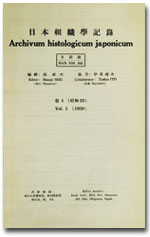All issues

Successor
Volume 31 (1969 - 197・・・
- Issue 5 Pages 495-
- Issue 3-4 Pages 181-
- Issue 2 Pages 83-
- Issue 1 Pages 1-
Volume 31, Issue 5
Displaying 1-4 of 4 articles from this issue
- |<
- <
- 1
- >
- >|
-
Hitoshi YOSHIKAWA1970Volume 31Issue 5 Pages 495-509
Published: 1970
Released on J-STAGE: February 20, 2009
JOURNAL FREE ACCESSThe arrangement of the neuron chains was studied by the fluorescence histochemical method of FALCK and HILLARP, to elucidate the distribution of monoamine containing nerve cells and the connection between nerve fibers in the sympathetic nervous system of the dog. Communicating rami and thoracic greater splanchnic nerve which center in the 13th thoracic ganglion, prevertebral ganglia, colonic nerve and intramural ganglia were subjected to observation. Section of nerves at various levels and administration of drugs affecting the metabolism of monoamines (reserpine and nialamide) were performed in addition to normal controls. The results obtained were as follows.
1. Monoaminergic fibers are not contained in the white communicating rami.
2. Non-monoaminergic nerve cells are found singly or in groups among fluorescent ones in both the para- and prevertebral ganglia (splanchnic and inferior mesenteric ganglia). Especially, they group in a definite region of the 13th thoracic ganglion where the white communicating rami penetrate.
3. Efferent monoaminergic nerve fibers are contained in the gray communicating rami, splanchnic and colonic nerve.
4. Monoaminergic nerve terminals are found around monoaminergic and nonmonoaminergic nerve cell bodies in both the para- and prevertebral ganglia.
5. There are two types of monoaminergic postganglionic fibers, namely short and long ones. The short axons terminate in the same ganglion where its own mother cell body is located, while long ones in a distant ganglion or intramural ganglia.
6. Nerve cells are non-fluorescent in the intramural ganglia of both Auerbach's and Meissner's plexuses.
From the above-described results ten defferent pathways, including five main and five subsidary ones, were proposed for the arrangement of the neuron chain from the lateral horn of spinal cord to the intestinal wall.View full abstractDownload PDF (5079K) -
A Proposal of a New Hypothesis on the Permeability of the Blood CapillariesShigeru KOBAYASHI1970Volume 31Issue 5 Pages 511-528
Published: 1970
Released on J-STAGE: February 20, 2009
JOURNAL FREE ACCESSPreviously underscribed colloidal particles were found under the electron microscope in one-third of 65 individuals of the snake, Elaphe quadrivirgata. They were electron dense, spheroid bodies of a uniform size (20mμ in diameter) and were mainly located in the blood plasma and in the perivascular connective tissue space throughout the whole body.
In the capillary wall they were found within intracytoplasmic vesicular structures of the endothelium, subendothelial space and in the basement membrane. These findings were interpreted to indicate their transport across the capillary wall.
The colloidal particles, though similar in size to some of the tracers used in the previous studies of vascular permeability, essentially differed from them in that they comprised a physiological component of the blood plasma.
In the present material, not only fenestrae but also chains of two or more vesicles perforated the endothelium completely. Diaphragms similar to those of capillary fenestrae were also found at the orifices of caveolae and at the junctions of two vesicles. The diaphragms either in fenestrae, caveolae or between vesicles inhibited the passage of the particles. They were postulated to contain the structural equivalent of the “small pore system” proposed by some physiologists and it was supposed that the so-called “transport in quanta” might be less efficient, at least in this animal, than the outflow of substances through the fenestrae and channels tunneling through the endothelium. This mechanism of substance transport proposed in the present study may be called transport in continuum.
The basement membrane of the renal glomerular capillaries completely stemmed the colloidal particles, though this membrane of other capillaries was permeable to them.View full abstractDownload PDF (11050K) -
Masahiro MURAKAMI, Yojo NAKAYAMA, Tatsuo SHIMADA, Noriharu AMAGASE1970Volume 31Issue 5 Pages 529-540
Published: 1970
Released on J-STAGE: February 20, 2009
JOURNAL FREE ACCESSThe subcommissural organ of the human fetus of both sexes from 5 to 8 months of age was studied by electron microscopy with special attention to physiological significance.
The subcommissural organ consists of tall columnar ependymal cells with long basal processes. The apical surface of the ependymal cell facing the third ventricle is provided with a number of microvilli, few cilia and occasional cytoplasmic protrusions. No structure corresponding to Reissner's fiber could be seen in the ventricle. The cytoplasm of the ependymal cells, although its electron density varies considerably from cell to cell, contains a large number of glycogen granules, a moderate number of mitochondria, a relatively well-developed Golgi complex, and bundles of microtubules running parallel to each other. The granular endoplasmic reticulum is scantily scattered in a tubular form in the cytoplasm except for the basal portion where the endoplasmic reticulum is frequently arranged in a concentric array.
In the subcommissural ependymal cells of the human fetuses examined, neither secretory sacs filled with the fine flocculent material characteristic of this organ in other species nor any morphological evidence for secretory activity in this organ could be detected. The results may indicate that in human beings the subcommissural organ is not secretory in nature, buy rudimentary.View full abstractDownload PDF (8675K) -
1970Volume 31Issue 5 Pages 541-544
Published: 1970
Released on J-STAGE: February 20, 2009
JOURNAL FREE ACCESSDownload PDF (444K)
- |<
- <
- 1
- >
- >|